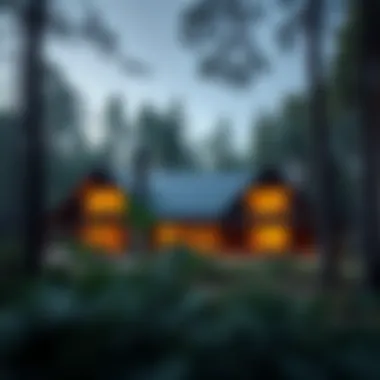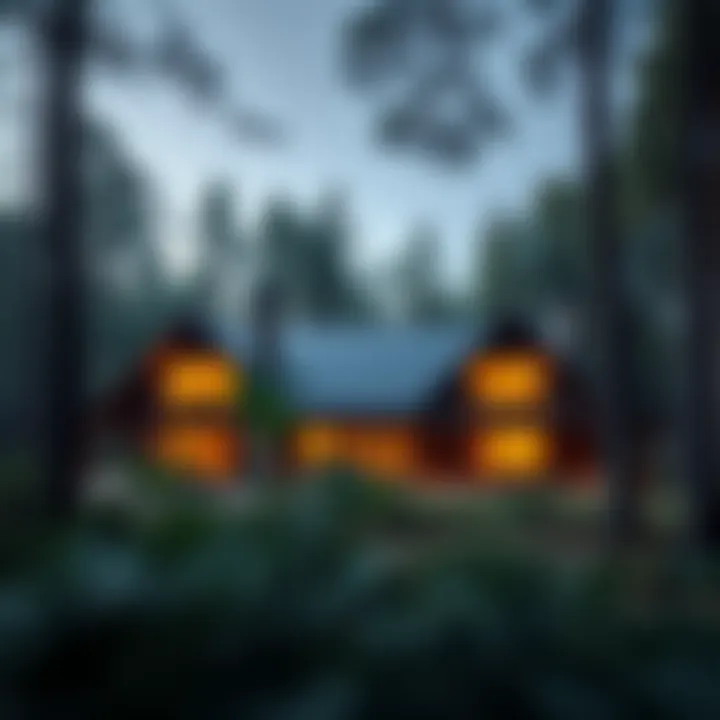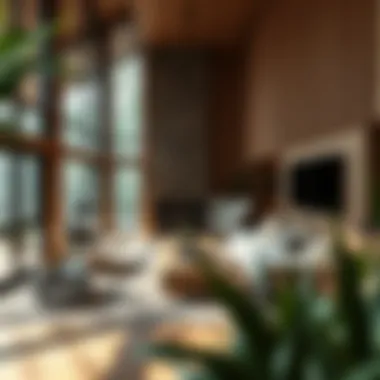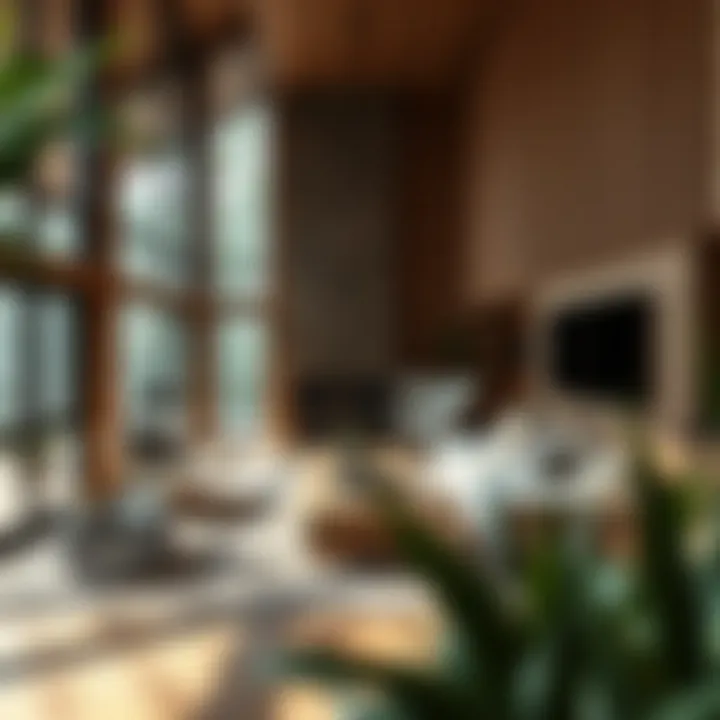Exploring Woodland Residences: A New Way of Living


Intro
In recent times, the allure of woodland residences has caught the attention of a diverse group of homebuyers, from families seeking a break from the chaos of urban life to investors looking for tangible assets in a fluctuating market. These homes, often nestled among towering trees and lush greenery, present a lifestyle choice that melds the tranquility of nature with the conveniences of modern living. As more individuals express a yearning to be closer to the earth, it becomes vital to explore the myriad characteristics and benefits of these unique living spaces.
Woodland residences are not just about the picturesque views or the serene environment—they embody a principle of sustainability that resonates with many current homeowners. They frequently feature eco-friendly designs, energy-efficient technologies, and materials that minimize environmental impact. This symphony of nature and architecture is particularly appealing for expatriates wanting to settle in a less conventional environment or for families desiring a safer, more peaceful enclave for their children.
As we delve into the essence of woodland living, we will highlight key aspects such as local architectural styles, sustainable practices, and the profound impact of location on one’s lifestyle choices. We will also take a look at market trends that define the landscape of woodland properties and scrutinize the investment potential for those pondering this harmonious blend of living. Furthermore, this exploration will tackle practical elements such as property listings and insights on the buying process—everything one would need to embark on this promising adventure into serene living.
Understanding Woodland Residences
Woodland residences have garnered interest in recent years, carving a niche in the real estate market. These homes represent more than just a roof over one’s head; they encapsulate a lifestyle choice that intertwines comfort with an immersion in nature. Understanding woodland living is crucial, especially for those considering a move away from urban hustle.
The Benefits of Woodland Living
One might ask, why opt for a home surrounded by trees and wildlife? The reasons are as plentiful as leaves on a forest floor.
- Tranquility: For many, the everyday noise pollution found in cities can be overwhelming. Woodland residences offer a natural noise barrier, creating a serene ambiance.
- Health Benefits: Studies have shown that spending time in nature can reduce stress, boost mental well-being, and even promote physical health.
- Community: These areas often foster a strong sense of community spirit. Residents tend to be more connected, sharing a mutual appreciation for the environment.
Thinking about investing in woodland properties also involves considering the sustainability aspects. Homebuyers today are often more conscientious of their impact on the environment, valuing properties that reflect ecological responsibility.
Defining Woodland Living
Woodland living isn’t merely about residing near trees; it encapsulates a lifestyle steeped in harmony with nature. Imagine waking up to the sound of chirping birds instead of the honking cars. Homes nestled in the woods present unique architectural designs, often utilizing natural elements like wood and stone. This connection with nature promotes well-being, ensuring that daily interactions are imbued with tranquility and beauty.
People often find inspiration from the surroundings as they engage in outdoor activities like hiking or bird-watching, reinforcing bonds with family or friends.
Historical Context of Woodland Homes
The concept of woodland homes is not just a contemporary whim; it has historical roots. Historically, various cultures have sought refuge and inspiration from nature. In northern Europe, log cabins became a popular building style, not merely for their aesthetic value but also for their practical benefits. They provided warmth in harsh winters and were often built using local timber, echoing the principles of sustainability.
As urbanization progressed in the 20th century, the narrative surrounding woodland homes began shifting. The rise of sprawling cities led many to yearn for the peace of the woods once again. It was in this context that a renewed interest in creating residences that celebrate the land emerged.
Today, the appeal of woodland homes continues to grow as modern buyers seek ways to obtain a slice of nature without completely severing ties with urban conveniences. Learning about this context not only enriches one’s understanding of woodland living but also enhances appreciation for the thoughtful design and sustainable practices that define these residences.
Architectural Styles in Woodland Residences
The architectural styles in woodland residences play a pivotal role in defining the identity and lifestyle of these homes. They serve as a bridge, merging the comforts of modern living with the natural beauty of the surrounding environment. This intricate dance between architecture and nature not only enhances the aesthetic appeal but also aligns with sustainable living practices. In this section, we will explore modern designs that embrace nature, traditional styles with a unique focus on locality, and the innovative use of materials that reflect ecological awareness.
Modern Designs Incorporating Nature
Modern architectural designs in woodland residences often focus on bringing the outside in. Large windows, open floor plans, and seamless transitions between indoor and outdoor spaces create a fluid environment that encourages residents to engage with nature. Not only do these features amplify natural light, but they also promote a sense of connectedness to the landscape.
For instance, a home designed with panoramic glass walls enables stunning views of the forest while maintaining comfort. Additionally, architects are increasingly incorporating sustainable materials, such as bamboo flooring or reclaimed wood, that resonate with the woodland surroundings. The idea is to create a home that feels like a natural extension of the landscape rather than an imposition on it.
Here are some benefits of modern designs that incorporate nature:
- Thermal Efficiency: Large windows capitalize on sunlight, reducing the need for artificial lighting.
- Visual Harmony: Designs that mimic natural forms reduce visual clutter, bringing a sense of tranquility.
- Enhanced Well-being: Studies show that exposure to natural light and views of greenery can significantly uplift mood and boost mental health.
Traditional Styles with a Woodland Twist
Contrasting modern designs, traditional woodland homes often carry a nostalgic charm, maintaining classic architectural styles that evoke a sense of history and craftsmanship. These homes tend to reflect their surroundings using local materials, such as stone or timber, creating a strong sense of place. A log cabin, for example, captures the essence of woodland living, offering rustic elegance and warmth.
Incorporating elements like steeply pitched roofs, large porches, and handcrafted details, these homes invite a slower pace of life. They not only pay homage to historical designs but also focus on high functionality amidst nature.
Some key aspects of traditional styles with a woodland twist include:
- Local Aesthetics: Structures are often built to blend with the environment, respecting natural topography.
- Craftsmanship: A focus on artisanal techniques elevates these homes, celebrating local talent and heritage.
- Durability: Traditional materials often withstand the test of time, ensuring longevity amid the elements.
Innovative Use of Materials
In the realm of woodland residences, the innovative use of materials is rising to the occasion, reflecting both sustainability and aesthetic considerations. Homeowners and designers are increasingly pivoting towards eco-friendly materials. This means sourcing products that have a lower environmental impact, such as recycled steel or biodegradable composites which substantially reduce carbon footprints.


The trend of using rammed earth walls or living roofs has also gained momentum. These materials not only offer thermal insulation but also foster biodiversity, allowing flora to thrive even atop a home. Such approaches highlight not only the blend of utility and sustainability but express an evolving understanding of our role in the natural world.
A few examples of innovative materials in woodland home design could include:
- Recycled Materials: Items repurposed reduce waste and give new life to what could have been discarded.
- Natural Insulation: Cotton or sheep wool can be used for insulation due to their excellent thermal properties and renewability.
- Smart Technologies: Solar panels and rainwater catchment systems seamlessly integrated into the design can enhance a home’s functionality.
"A well-designed woodland home is not just a structure; it’s a dialogue between the occupant and the environment, fostering mutual respect and understanding."
Whether one gravitates towards the sleek lines of modern designs, the rustic charm of traditional styles, or the bold choices of innovative materials, each architectural approach encapsulates a unique interpretation of woodland living. This diversity in design reflects the myriad ways in which we adapt our habitats to foster comfort, sustainability, and connectivity with nature.
Sustainability in Woodland Residences
Sustainability is not just a buzzword; it’s a critical framework around which woodland residences are constructed and developed. This concept goes beyond the aesthetic appeal of living amid trees and nature; it brings into focus the long-term viability of these properties within our ecosystems. The importance of sustainability in woodland living comes from a collective need to harmonize human habitats with the natural world. For those considering buying a home in these areas, understanding the sustainable practices at play can enhance not just your living experience but also your investment’s future value.
Eco-friendly Building Practices
Building in the woods demands respect for the surroundings. Eco-friendly practices aim to reduce the environmental footprint of construction by using sustainable materials and methods. Many woodland homes utilize local resources, thus decreasing transportation emissions. Reclaimed wood, for example, is popular because it’s not only sustainable but also adds character to a home. For instance, using logs from nearby fallen trees can create a rustic aesthetic while maintaining ecological integrity.
Builders often employ designs that minimize land disturbance. This means homes can be nestled into the landscape rather than clearing wide swaths of forest or grassland. Green roofs, which support local flora, are another significant trend. Not only do these roofs help insulate homes, but they also blend the structure into its natural environment, creating a visual harmony with the woods.
Renewable Energy Solutions
One of the shining aspects of woodland residences is their ability to incorporate renewable energy solutions. Solar panels are a common sight, converting sunlight to energy and drastically reducing dependence on fossil fuels. Imagine waking up to the sun shining on your roof, generating power for your daily needs, all while reducing your carbon footprint.
Another noteworthy solution is wind energy. In regions where the breeze blows strong, small wind turbines provide an additional source of clean energy. Moreover, homeowners can install geothermal heating and cooling systems to regulate their home's temperature. These systems use the earth’s natural heat and are incredibly efficient, further promoting sustainable living.
Landscaping that Preserves Ecosystems
Landscaping in woodland residences is not just about aesthetics; it’s a responsibility towards the local ecology. Sustainable landscaping practices focus on preserving local ecosystems by using native plants. Such plants are adapted to the local climate and soil, requiring less water and few or no pesticides.
Creating habitats for local wildlife can enhance biodiversity. Many homeowners choose to plant native trees and shrubs that provide food and shelter for birds and insects. Rain gardens, designed to manage stormwater runoff, are another great option. These gardens not only beautify a property but also ensure that water is absorbed back into the ground rather than being diverted into storm drains.
According to experts, tending to the land with ecological mindfulness can lead to healthier environments. When homeowners understand their landscaping’s impact, it fosters a sense of stewardship that benefits both their immediate surroundings and the broader ecosystem.
"Sustainable practices not only enhance the beauty of woodland living but also protect the natural environment for future generations."
By weaving sustainability through the fabric of woodland living, homeowners can enjoy both the comforts of modernity and the timelessness of nature, creating a living experience that is not only beautiful but also responsible.
Location Considerations for Woodland Homes
When it comes to choosing a home in a woodland setting, location is king. The benefits of selecting the right spot can hit home in ways that mere aesthetics simply can't capture. Understanding the unique attributes of woodland residences allows potential homeowners to align their desire for a tranquil lifestyle with practical needs that cater to modern living.
Proximity to Urban Centers
Living in a woodland area does not have to mean being completely off the grid. In fact, many woodland residences are strategically positioned with reasonable proximity to urban centers. This allows residents to enjoy a quieter lifestyle while still being close enough to city amenities. For instance, those who work in the bustling atmosphere of the city can find solace in the woods, perhaps a mere 30-minute drive from their workplace.
This balance between nature and urban convenience lent itself to a rising trend in suburban developments that offer woodland residences. Schools, hospitals, and shopping centers become easily accessible, while residents can return to their peaceful retreats at day’s end. This duality can be particularly appealing for families or expatriates who wish to experience the serenity of nature without forfeiting the conveniences of urban living.
"The key to a successful woodland residence is finding harmony between the wild and the urban, where life can flourish both in the heart of nature and amidst lively city streets."
Access to Recreation and Nature Trails
One of the hallmark attractions of woodland living is the abundance of outdoor activities, thanks in large part to the proximity of parks, trails, and recreational areas. Many woodland homes boast easy access to hiking, biking, and walking trails, offering a rich palette for outdoor enthusiasts.
- Hiking: With trails weaving in and out of thick foliage, outdoor adventurers can lose themselves (figuratively, of course) while still being merely steps away from home.
- Biking: For those who prefer a quicker pace, feeling the breeze on a well-maintained bike trail can be invigorating.
- Wildlife Watching: The chance to see native fauna can easily turn a simple backyard into a viewing gallery of nature.
Access to such recreational opportunities not only enhances the quality of life but fosters community spirit. Neighbors share trails, enjoy weekend barbeques, and bond over shared experiences out in the fresh air. This creates a vibrant social environment, nurturing connections that go beyond mere proximity.
Evaluating Neighborhood Characteristics


Not all woodland areas are created equally, which is why evaluating the neighborhood characteristics becomes vital to long-term satisfaction. Prior to moving in, potential residents should consider a few key factors.
- Community Vibe: Is the neighborhood a tight-knit community where neighbors frequently socialize? Or is it more laid-back, where people keep to themselves? Knowing the vibe can set the right expectations for interaction and personal space.
- Amenities: Examine what facilities are available nearby. Access to grocery stores, schools, and recreational centers can differentiate one community from another. Those that strike a balance between rustic charm and everyday essentials can be more appealing.
- Safety and Security: Research safety ratings and crime statistics. Peace of mind is mantra when you’re surrounded by nature.
Someone might find themselves enchanted by a beautiful home only to discover that the neighborhood’s characteristics clash with their lifestyle. Therefore, conducting thorough research will play a significant role in determining the perfect place that feels like home.
Considering these location elements helps prospective homeowners make informed choices about their woodland residences, creating an ideal space that blends the joys of peaceful living with the demands of everyday life.
Market Trends in Woodland Residences
Understanding market trends in woodland residences is crucial for potential buyers, investors, and developers. This section shines a light on the current landscape of woodland homes, the factors that influence demand and supply, and how buyer preferences are shifting over time. With more people looking to escape city life for quieter and more nature-centric environments, grasping these trends can open up opportunities for sound investment and enriching living experiences.
Current Demand and Supply Dynamics
The desire for woodland living has seen a notable uptick in recent years. People, especially those commuting from urban environments, have been seeking homes that offer both tranquility and accessibility. This demand is contributing to short supply in many picturesque woodland communities. For instance, regions around the Appalachian Mountains and the Pacific Northwest are witnessing a sharp rise in interest, with listings getting snagged faster than hotcakes at a Sunday brunch.
Among identified factors influencing demand:
- Work-from-Home Flexibility: The ongoing changes in workplace culture have allowed many individuals to reconsider their living situations. With the capability to work remotely, buyers are increasingly turning to woodland residences, valuing serene surroundings over proximity to office environments.
- Health and Wellness: A heightened awareness of mental health has people wanting to connect with nature. Woodland living often embodies a healthier lifestyle, supported by opportunities for outdoor activities such as hiking and biking, enhancing overall well-being.
- Investment Value: Investors are eyeing these properties not solely for personal use but as lucrative opportunities that might appreciate over time. Many think that as urban areas become bustling metropolises, woodland areas will grow in value as more people seek solace beyond city limits.
However, it's important to note that while demand is growing, the supply often lags. It can be challenging to find suitable properties outfitted with the right amenities—especially for families looking for modern conveniences amidst serene landscapes. This imbalance drives prices higher, making it essential for buyers to act quickly when they find a property that meets their needs.
Shifts in Buyer Preferences
As the landscape of woodland living evolves, so do the preferences of its buyers. Today's homebuyers are not just looking for a place to call home; they are seeking experiences, connections, and sustainability in their living environments.
- Emphasis on Sustainability: Many buyers now prefer homes with eco-friendly features. Energy-efficient designs and sustainable materials are becoming essentials rather than perks. Buyers actively seek properties that align with their values towards environmental conservation, looking into energy sources or sustainable landscaping.
- Community Focus: There’s a shift beyond the mere structure of a home; prospective buyers are increasingly interested in being part of a community. Understanding the ethos and dynamics of a locality can greatly influence purchasing decisions. They tend to gravitate towards neighborhoods that promote communal activities, nature walks, and social events.
- Technology Integration: As smart homes continue to gain traction, buyers also seek homes with integrated technology that allows for convenience and security. Features such as automated lighting, security systems, and energy management tools are high on the list of desirable attributes.
"The demand for woodland homes not only resonates with current lifestyles but embodies a movement towards valuing nature and community in housing choices."
For in-depth analyses and reports on real estate trends, you might find useful insights at National Association of Realtors or Realtor.com.
Exploring these dynamics not only equips potential buyers but also helps developers strategize for success in the ever-evolving market of woodland residences.
Investment Potential of Woodland Properties
The allure of woodland residences extends beyond the immediate appeal of natural beauty and serene living. Investors and potential homeowners alike should take a moment to explore the investment potential these properties hold. As urban areas become more congested and unpredictable, a shift towards tranquil living is evident. This trend not only offers a refuge from the bustling city life but also represents a promising financial endeavor.
Long-term Value and Resilience
One of the most striking features of woodland properties is their long-term value. Unlike many urban properties that can experience sharp fluctuations based on market trends or local economies, woodland homes tend to be resilient. The reason behind this resilience can be traced back to their connection with nature. People are increasingly valuing green spaces and eco-friendly lifestyles, and as demand grows, so does the inherent worth of these homes.
- The increase in remote work families seeks proximity to outdoor amenities and natural landscapes.
- Properties that prioritize sustainability, such as energy-efficient features and organic materials, often find favor in the market, catering to environmentally-conscious buyers.
Moreover, woodland living offers a buffer against economic downturns. Even when markets fluctuate, properties in appealing natural settings maintain their desirability, as many seek an escape from urban stress.
Investing in woodland residences also provides a chance to engage in eco-friendly practices. This not only contributes to a healthy ecosystem but can also enhance property value. Many buyers are looking for homes where they can reduce their carbon footprints and prioritize sustainable living.
Comparative Analysis with Urban Real Estate
When considering the comparative analysis of woodland properties versus urban real estate, it is important to realize the stark differences in lifestyle and investment outcomes. Urban properties frequently come with a higher price tag, driven by demand for limited space and convenience. In contrast, woodland homes often provide a larger footprint for a more reasonable investment.
- Cost-Effectiveness: The price per square foot in woodland areas tends to be lower compared to metropolitan centers. This allows for larger properties or even the chance to invest in additional land.
- Maintenance Costs: While urban homes may demand high maintenance fees due to shared spaces and amenities, more secluded woodland living often mandates less stressful upkeep.
- Potential for Appreciation: As urban expansion continues, many woodland areas are recognized as desirable escapes. Investing in such regions now can yield significant appreciation in the coming years as more people choose nature over concrete.
Investing in woodland properties is not merely the purchase of a home; it is an investment in lifestyle, sustainability, and often, a brighter financial future.
In summary, the potential benefits of investing in woodland properties are multi-faceted, reflecting not only long-term financial gains but also positive lifestyle choices. Families, expatriates, and savvy real estate investors should give these unique opportunities a closer look before they are claimed by the market.
Challenges of Woodland Living


Living in woodland residences, while often seen as a dream come true, comes with its own set of challenges that must be navigated carefully. It's essential to keep in mind that the allure of a tranquil home surrounded by trees and nature is accompanied by practical considerations that can significantly impact the living experience. Understanding these challenges is crucial for anyone considering a move into a woodland area, whether you are a real estate investor, a family seeking a peaceful abode, or an expatriate looking for a fresh start.
Navigating Nature’s Elements
Woodland living invites you to connect deeply with nature, but it also means facing the unpredictable elements that come with it. From heavy snowfall in winter to fierce storms in summer, the elements can pose various threats to both the property and its inhabitants. It becomes vital to assess local weather patterns and build accordingly.
- Winter preparation: Insulating the home properly is essential to maintain warmth and reduce heating costs. Many woodland properties use natural materials like wood for insulation, which not only blends with the surroundings but also offers energy efficiency.
- Flooding and drainage: Those located near water bodies must consider drainage solutions to prevent homes from flooding. Effective landscaping strategies can redirect water away from the foundation.
- Wildfires: In forests, especially during dry seasons, the risk of wildfires is something every potential homeowner must ponder. Creating defensible space around the property, using fire-resistant materials, and keeping the landscape well-managed can mitigate these risks.
Being well-informed about potential natural hazards and preparing accordingly can make the difference between a serene existence and a constant battle against the elements.
Balancing Wildlife Interaction
Another unique aspect of woodland living is the rich wildlife that surrounds these homes. While the presence of animals can be enchanting, it does introduce its one set of complexities. As nature’s visitors, residents must navigate the delicate balance of coexisting with wildlife, ensuring safety while maintaining admiration for our furry neighbors.
- Visitor management: Encounters with deer, raccoons, and even bears are daily occurrences in woodland residences. Homeowners might need to invest in secure trash bins to keep smell-sensitive creatures at bay. Fencing might be necessary to protect gardens and other plants from being nibbled away.
- Seasonal migrations: With various species migrating at different times of the year, residents ought to be aware of changing wildlife patterns. Certain times might see an influx of animals, requiring extra vigilance.
- Conservation challenges: Striking a balance between human enjoyment of nature and preserving wildlife habitats is key. Engaging with local conservation groups and participating in community initiatives can enhance understanding and also promote wildlife-friendly practices in residential settings.
Understanding the intricacies of wildlife interaction fosters not only a harmonious living environment but also enriches the community’s overall appeal, transforming challenges into opportunities for learning and growth.
Navigating nature's whims and fostering positive wildlife encounters are just part of the journey of woodland living, illustrating that it’s not just a choice of house but a lifestyle that requires continuous adaptation and respect for the natural world.
Community and Lifestyle in Woodland Areas
Woodland living does not just offer an escape from the hustle and bustle of urban life; it nurtures a sense of community and a lifestyle that many find increasingly appealing. In this section, we will explore the elements that foster community in these tranquil settings as well as the myriad benefits that arise from immersing oneself in nature.
Building a Connected Community
A significant advantage of settling in woodland areas is the opportunity to cultivate strong ties with neighbors. These communities often consist of like-minded individuals who share an appreciation for nature and a slower pace of life. Residents tend to be more involved in local events and initiatives, fostering a connected environment.
- Neighborhood Gatherings: Regular events, such as farmers’ markets or seasonal festivals, create opportunities for residents to mingle. These gatherings allow for exchange not only of goods but also of stories, thereby binding the community closer.
- Shared Interests: Woodland areas often attract those with a common interest in outdoor activities like hiking, gardening, or conservation. Groups form around these interests, reinforcing connections and creating a supportive network amongst families and individuals.
- Community Projects: Initiatives such as tree planting days or clean-up efforts bring residents together. These projects not only enhance the local environment but also strengthen social bonds.
Overall, the intrinsic nature of woodland residences encourages a neighborly atmosphere. When people are equally invested in caring for their surroundings, a true community thrives.
Lifestyle Benefits of Living in Nature
The lifestyle afforded by woodland living is replete with benefits, both mental and physical. Nature brings a kind of peace that urban environments often lack, nurturing a sense of wellbeing that permeates everyday life.
- Health Advantages: Studies increasingly show that living closer to nature can lead to better health outcomes. Fresh air and green spaces promote physical activity, reducing the likelihood of lifestyle-related illnesses. It’s not just about running through the trees; calmer activities like yoga or simply enjoying a book on the porch can contribute to significant improvements in mental health.
- Reduced Stress: The gentle rustle of leaves and the sight of wildlife have therapeutic qualities. A woodland home offers a sanctuary away from daily stressors—whether it’s work, city noise, or the frenetic pace of modern life.
- Family Bonding Opportunities: Spending time in nature fosters deeper connections among families. Outdoor activities, whether they be hiking, picnicking, or simply observing wildlife, provide quality time that strengthens relationships.
- Mindfulness and Connection: Woodland living encourages mindfulness—being present and appreciating the little things like a sunrise or the sound of rain falling on leaves. This connection to one's environment can lead to a more fulfilling and satisfying life.
"Living in harmony with nature at your doorstep allows one to experience the world differently, appreciating the way the simple things invite reflection and connection."
As urban areas become more crowded and stressful, there is a growing movement towards woodland communities for both lifestyle improvement and community building. The essence of woodland life—its slower pace, natural beauty, and collaborative spirit—allows many to find their nook in a beautifully interconnected society.
End: The Future of Woodland Residences
As we step into an era where urban sprawl and environmental concerns seem to clash, the concept of woodland residences emerges as a beacon of balance. This reflective piece concludes with an exploration of the future prospects of woodland living, addressing how these unique homes can play a pivotal role in accommodating the growing demand for sustainable yet vibrant lifestyles.
Prospective Developments
Looking forward, there’s a palpable shift occurring in how developers approach woodland projects. More than mere houses, these constructions are being envisioned as integrated components of their natural environment. Forested areas are becoming not only spaces for living but also ecologically viable communities offering amenities that promote a healthy lifestyle. For instance, the principle of biophilic design, which connects inhabitants with nature, is gaining traction. This approach involves incorporating natural light, organic materials, and views of greenery into the architectural framework.
Further enhancing this trend, smart home technology is increasingly intertwined with woodland residences, allowing for energy-efficient systems that complement sustainable building practices. Think solar panels, rainwater harvesting, and even temperature-regulating systems all working in harmony with nature's elements.
"Woodland living is not just about residing in nature; it's about coexisting with it, and that requires innovation and foresight."
Moreover, as urban infrastructures grow increasingly crowded, many developers are eyeing woodland areas as havens to create new communities that blend serenity with a modern twist. They are initiating eco-villages that emphasize responsible living while fostering a sense of community—an aspect often lost in fast-paced city life.
Evolving Buyer Profiles
In tandem with these developments, the profiles of buyers seeking woodland residences are evolving. Traditionally, such homes might have attracted retirees or nature enthusiasts, but the landscape is shifting. Today’s buyers are no longer one-dimensional; they encompass a rich tapestry of demographics. Hence, it's crucial to understand who these individuals are and what they seek in their new homes.
Families looking for space and safety might find woodland locations inviting, particularly for children who can roam freely and engage with nature. Young professionals are also an emerging demographic—seeking a retreat from the hustle and bustle along with remote work options. They desire homes that not only serve as a living space but feel like an escape, a place to recharge from their fast-paced careers.
Expatriates have also begun to view woodland residences favorably; they value the chance to embrace nature while integrating into simpler ways of living. The appeal of clean air, vibrant wildlife, and community connection are strong attractive forces.
In summary, the trajectory for woodland residences looks promising. The interplay of innovative development practices and the diverse buyer profiles sets the stage for a future where these homes not only deliver physical shelter but also cultivate harmony with the world around them. The vision for woodland living is becoming clearer—it's about creating a sustainable and enriching lifestyle, grounded in the heart of nature.



